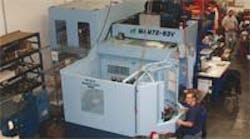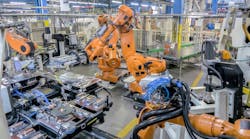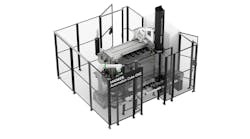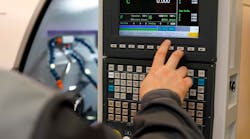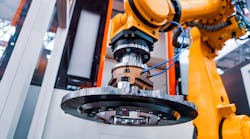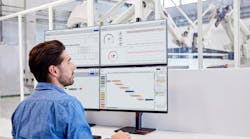Mac Machine Co. Inc. implemented multi-pallet horizontal machining centers over 20 years ago and quickly discovered the ability to run them unattended, unheard of at the time. But more important for the shop, the new equipment marked the beginning of its specialization in short-run, high-mix production, a practice for which set-up time often makes or breaks meeting delivery times and turning a profit.
Among the components produced by Mac Machine are mechanical parts used in space suits for the Space Shuttle and components for the Joint Strike Fighter, as well as items for submarines, missiles, rocket motors and ejector seats. Other work includes components for diagnostic medicine and surgical implants, along with parts for commercial satellites and aircraft. All 60 of the shop’s employees are keenly aware of the human safety issues connected with the perfect functioning of every component produced there, and they are dedicated to producing top quality work and delivering jobs on time.
Prior to switching to multi-pallet systems, Mac Machine used singleand twin-spindle vertical machines that required lengthy set-up times and were unsuitable for lights-out operations. Today, the shop has 13 highly automated Matsuura 4-axis and 5-axis multi-pallet horizontal and vertical machining centers supplied by Methods Machine Tools, Matsuura’s North American importer.
The transition to multi-pallet systems eliminated over 50 percent of the shop’s previously required operations by completely machining a part in just one cycle. This type of machining has also increased the shop’s competitiveness in all the markets it serves.
Among Mac Machine’s Matsuura 13 multi-pallet machines is the MAM72-63V 5-axis machine that processes large geometrically complex components within a work envelope of 24.8 in. by 17.7 in. high, with a weight capacity of 770 lb. The shop also uses a MAM72-35V, a smaller 5-axis machine for work measuring to 13.7 in by 9.44 in., and an H.Plus-300 Series horizontal machining center.
Matsuura specializes in stand-alone multi-pallet systems for processing complicated workpieces with unattended handling for as few as two pallets to as many as 32 pallets. With 32 pallets, Mac Machine can make up to 32 completely different parts, one right after another, on one milling machine.
With the Matsuura machine configurations, Mac Machine automates the machining of its most difficult pieces because of the machines’ abilities to virtually eliminate interference areas. By way of a fixed spindle and tilting table configuration, the rigidity of the tool and toolholder is maximized when milling awkward or otherwise impossible workpiece features, even when machining an irregularly shaped piece as large as 24.8 in. in diameter.
But according to George McNab, president of Mac Machine, it is the ease and flexibility of set-up that give the shop its edge within its demanding core competencies. Plus, with 12,000 to 20,000-rpm spindles and advanced Matsuura servo drive systems, the MAM72 series machine helps reduce cycle times by 60 percent.
Mac Machine also depends on CAMplete TruePath software furnished with the Matsuuras for bridging the gap between CAM input and the machining centers. Instead of blindly sending the output of a CAM system through a post-processor to its 5-axis machines, the shop uses TruePath to analyze, modify, optimize and simulate 5-axis toolpaths in a seamless five-view 3D environment to avoid problems on the machine.
John Leonard, Mac Machine shop foreman, believes that the CAMplete TruePath software has played a pivotal role in the success of the shop’s lights-out machining. Operators can preview the entire routine, and anticipate and correct potential issues before any machining even starts, thus drastically reducing set-up time and providing an invaluable edge over the competition.
The combination of Matsuura multipallet systems and CAMplete software has reduced set-up times by 85 percent and slashed cycle times up to 70 percent by reducing the number of operations required to machine a part at Mac Machine. Even with these cycle time savings, the biggest benefit has been automating short run, high-mix jobs.
“Unattended machining has allowed us to operate second and third shifts with fewer machinists. This effectively reduces our labor rate by 30 percent and makes us more competitive,” said McNab.
With a high number of projects constantly churning, he believes the biggest challenge for the shop is to keep set-up times as short as possible. And, he said that the shop’s core competency is using multi-pallet machining systems to reduce set-up times for small production lots, continuously.
Building on that core competency, Mac Machine has earned a reputation for taking on the work most other shops might decline. While doing so creates strong customer relationships, it also has led to a consistent demand for smaller lots, lower pricing and zero tolerance for error.
“We must anticipate problems in advance and take corrective action before the green button is pushed,” said McNab. “We have to make good parts right the first time.”
He added that today’s products essentially need to be error-free, and his shop has a percent parts-per-million (ppm) rate of less than 1,000, which means, for example, it might have a “smudged” part number on one part out of 1,000 parts. To maintain this near-error-free output, Mac Machine also depends on a climate-controlled quality lab for compliance with strict quality control measures.
Besides having capable automated machining centers, consistently achieving near perfection requires highly skilled people. The shop operates on three shifts running lights-out 90 hours per week, out of an available 168 production hours.
Specialized “set-up machinists” help meet the needs of lights-out production at Mac Machine. These machinists work the first shift to get new work prepared for the multipallet production line. The second shift is a much smaller crew consisting of seven or eight individuals who monitor the automated systems and make certain they are in order for the lights-out third shift.
In addition, Mac Machine relies on Methods Machine Tools to supply and support the shop’s Matsuura systems. McNab credits the supplier with providing the equipment, expertise, programming assistance and responsive support needed to make lights-out production work.
